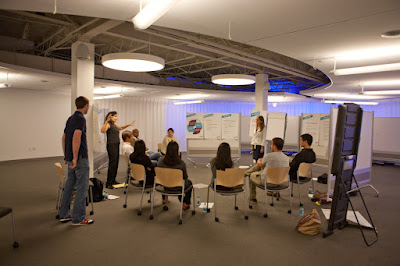Welcome to the new classroom.


That is, the newest classroom at Harvard Business School (HBS), “Hives.”
Launched in time for last year’s fall semester, Hives have been drawing praise at the school for conforming to the evolving learning needs of business, particularly among Harvard’s field-method courses in its MBA curriculum, said Gabe Handel, managing director of the Dean’s Office at HBS.
But don’t get too used to what you see in the above photo; the Hives at Harvard are completely transformative in every sense of the word. All tables, chairs and white boards in the 10 non-identical Hive classrooms are moveable in a purposefully rounded room.
The flexibility, Handel said, is designed to give both students and professors the ability to have a more collaborative friendly learning environment, a reflection of how both learning and business education has evolved in recent years.
“The students have a very different reaction coming into [the Hives] than in other parts of Harvard,” Handel said.

Previously Harvard’s case based MBA coursework was held in a more traditional setting, where a professor stood in front of a group of students in a modified lecture-style hall. These classrooms, known as Aldrich design rooms, still play well to the traditional case method of teaching.
But in 2008, HBS’ centennial, the school began to rethink how coursework needed to be more centered on teamwork and collaboration. “The case method is fantastic for putting students as the protagonist in a situation,” Handel said, “but there is a difference between that analytical knowledge and that hands-on experience of the doing.”
Such a desire for greater interaction, collaboration and teamwork in learning wouldn’t fit well in an Aldrich classroom.
“We wanted the focus really to be on flexibility,” Handel said. “Imagine the kind of interaction shifting from an Aldrich classroom through the key learning moments [and] imagine going instead to an oval classroom with all the students and 15 teams of six around circular tables with the faculty member at the center. There’s an opportunity there for the teams to be doing individual work and the faculty to have a clear vision of each team.”

(Photos courtesy of Susan Young; above rendering courtesey of Architects of Group Genius)
Classroom-based learning, while still a mainstay in traditional education, has somewhat eroded in popularity in corporate learning circles as technology garners favor with firms that find learning more efficient when delivered at an individual level.
That isn’t to say that the classroom experience has gone away completely in this vein. In fact, some corporations have sought to modernize their classroom learning experience to provide greater collaboration and group-based learning.
Oak Brook, Ill.-based McDonald’s Corp. is just one example of a firm that has shifted its classroom to rounded tables designed for team-based learning. The idea, said Chris Lyons, McDonald’s vice president of worldwide training, learning and development, in an interview in July, was to eliminate both the front and back of the traditional classroom.
The Hive model takes that thinking a few steps further. Not only does it jettison both ends of a classroom, but the room’s circular shape and moveable furniture gives the teacher — and the students — complete flexibility in how learning is facilitated during each lesson. Room configuration could change multiple times per session depending on the learning needs.
Handel said the school is still toying with how to improve the Hive design and functionality. One wrinkle, he said, has been with some of Harvard’s faculty, many whom have had to adjust their teaching style to the Hive format after years of teaching in an Aldrich-style classroom.
In the Hives, the students and their group work are the focal point, while the professor roams throughout with nearly equal visibility of each and every team in the room.
Frank Kalman is an associate editor of Chief Learning Officer magazine. He can be reached at fkalman@CLOmedia.com.














